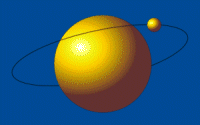Rydberg Atoms: Two’s Company, Three’s Still Company
David Norris
Once relegated to the margins of atomic physics research as basically tunable microwave antennas (albeit with enviable success), highly excited “Rydberg” atomic states have experienced a resurgence of interest in the past decade at the hands of the quantum information community, owing to their giant polarizability and long natural lifetime. In particular, the strong long-range interactions between excited Rydberg atoms can give rise to a “blockade” effect, in which one optically excited Rydberg atom inhibits the excitation of its neighbors, paving the way for new developments in such fields as single-photon nonlinear optics, quantum networks, and novel many-body quantum states.
The Rydberg wave continues unabated at QIM 2014, with an invited talk from Antoine Browaeys of the Institut d’Optique regarding his group’s recent progress in building microscopic arrays of interacting Rydberg atoms for use in quantum simulation. Antoine’s team made a huge splash in 2009 as one of two labs in the world to simultaneously demonstrate controlled Rydberg blockade (and later, entanglement) between individual trapped neutral atoms, and they have been perfecting their tools for single-atom control ever since.
Last year, Antoine’s group published the first direct measurement of the van der Waals interaction between a pair of atoms as a function of separation distance, showing the transition from collective Rabi oscillation to full blockade. Now, as detailed in a recent preprint, they’ve expanded into measurements of three-body physics, using a spatial light modulator to generate patterns of dipole traps at varying distances, and measuring the Rydberg excitation probability for a triplet of atoms in different geometries.
The build-up from two- to three-body interactions is a notoriously treacherous step in physics, and indeed some calculations have led researchers to question whether the Rydberg blockade and high-fidelity quantum gate operations can still operate effectively with more than two atoms, in particular when interactions are not spatially isotropic. The Institut d’Optique experiments show that, at least for the states used here, multiple Rydberg atoms can indeed play together nicely, with the blockade effect persisting even for anisotropic D-state interactions. This is very encouraging news to the community of researchers (like myself) working toward experimental implementations of many-body Rydberg excitations in cold gases, and confirmation of the utility of Rydberg atoms for future quantum simulation experiments.
We’ll hear all about the new results on Thursday, March 20, during Antoine’s talk at QIM 2014, and hopefully also some word on their implementation of other spatial arrangements, given the group’s demonstrated prowess with novel trap geometries. (I wonder how many atoms it takes to spell out the Institut d’Optique logo…?)

